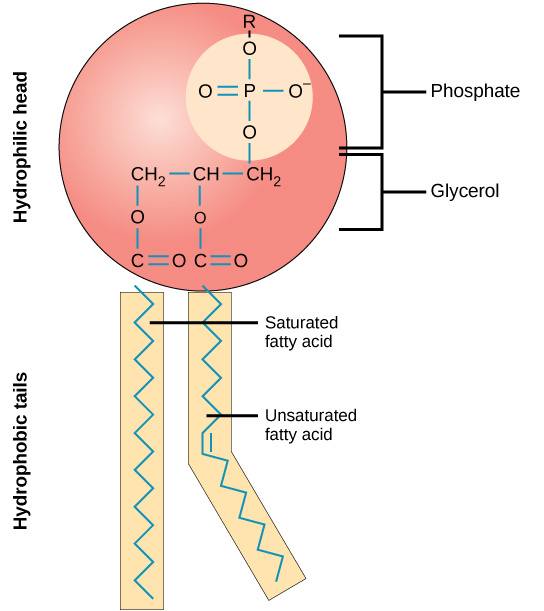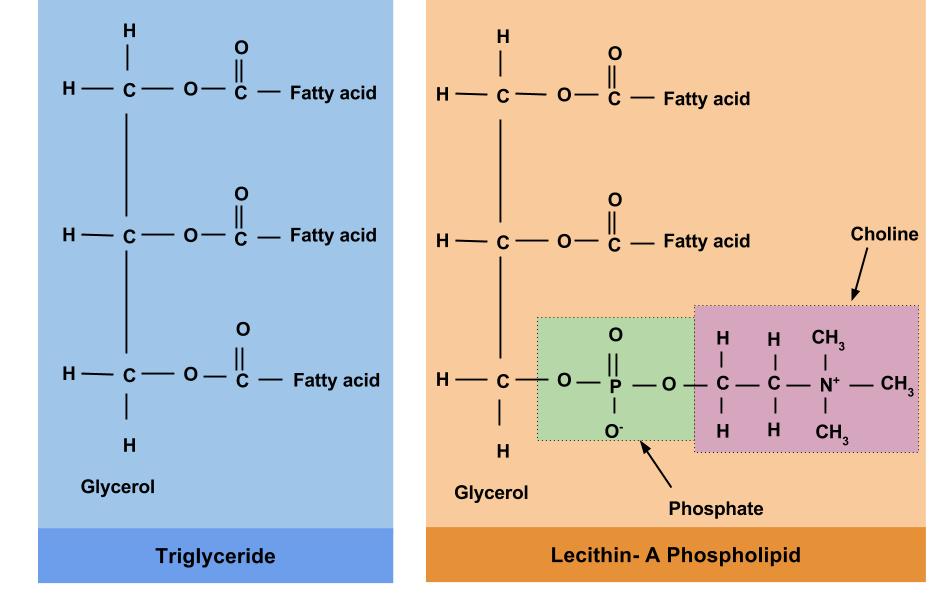Chapter 5. Lipids
Phospholipids and Sterols
Phospholipids
Like triglycerides, phospholipids have a glycerol backbone. But unlike triglycerides, phospholipids are diglycerides and contain two fatty-acid molecules attached to the glycerol backbone. The third carbon of the glycerol is occupied by a modified phosphate group. This unique structure makes phospholipids water soluble. Phospholipids are what we call amphiphilic—the fatty-acid sides are hydrophobic (dislike water) and the phosphate group is hydrophilic (likes water).
In the body, phospholipids bind together to form cell membranes. The amphiphilic nature of phospholipids governs their function as components of cell membranes. The phospholipids form a double layer in cell membranes, thus effectively protecting the inside of the cell from the outside environment and simultaneously allowing for the transport of fats and water through the membrane.

Phospholipids are ideal emulsifiers that can keep oil and water mixed. Emulsions are mixtures of two liquids that usually do not mix. Without emulsifiers, the fat and water content within food would be somewhat separated. Lecithin (phosphatidylcholine), found in egg yolk, honey, and mustard, is a popular food emulsifier. Mayonnaise demonstrates lecithin’s ability to blend vinegar and oil to create the stable, spreadable condiment that so many enjoy. Food emulsifiers play an important role in making the appearance of food appetizing. Adding emulsifiers to sauces and creams not only enhances their appearance but also increases their freshness.

Sterols
Sterols have a very different structure from triglycerides and phospholipids. Most sterols do not contain any fatty acids but rather contain multi-ring structures. They are complex molecules that contain interlinking rings of carbon atoms, with side chains of carbon, hydrogen, and oxygen attached. Cholesterol is the best-known sterol because of its role in heart disease and it is found in the fatty part of animal products such as butter, eggs, whole milk and meat. It forms a large part of the plaque that narrows the arteries in atherosclerosis. In stark contrast, cholesterol does have specific beneficial functions in the body. Like phospholipids, cholesterol is present in all body cells as it is an important substance in cell membrane structure. Approximately 25 percent of the cholesterol in the body is localized in brain tissue. Cholesterol is used in the body to make a number of important things, including vitamin D, glucocorticoids, and the sex hormones progesterone, testosterone, and estrogens. Cholesterol is also an important component found in bile. Notably, the sterols found in plants resemble cholesterol in structure. However, plant sterols inhibit cholesterol absorption in the human body, which can contribute to lower cholesterol levels.
Although cholesterol is preceded by its infamous reputation, it is clearly a vital substance in the body that poses a concern only when there is an excess accumulation of it in the blood. The body can synthesize cholesterol in organs such as the liver and intestines. In many people, the dietary consumption of cholesterol causes the body to down-regulate its production to ensure blood cholesterol levels are maintained at healthy levels.

Media Attributions
- The structure of a phospholipid © LibreTexts is licensed under a CC BY-NC-SA (Attribution NonCommercial ShareAlike) license

